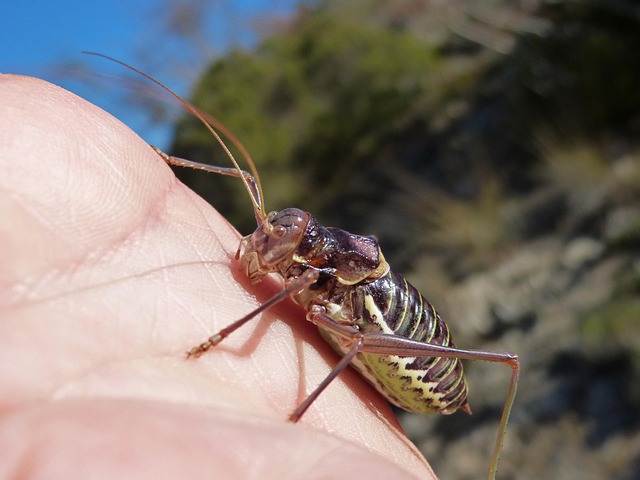Cricket infestations in residential and commercial areas pose challenges, impacting quality of life and property value. Traditional chemical methods are being replaced by humane and eco-friendly alternatives like natural repellents, mechanical traps, sanitation, and lawn care. In commercial settings, effective cricket extermination is crucial for hygiene, preventing loss of goods, and protecting business reputation. Emerging solutions include integrated pest management (IPM), biological control, non-toxic baits, and natural predators. Preventive measures like sealing entry points and maintaining hygiene, alongside long-term strategies like habitat modification and biological control, promote sustainable cricket control without harmful chemicals.
In the face of persistent cricket infestations, businesses and property managers are increasingly seeking humane and environmentally friendly solutions. This article explores effective cricket control methods beyond traditional extermination techniques, focusing on minimizing ecological impact while ensuring commercial spaces remain pest-free. We delve into the understanding of cricket behavior, compare traditional vs. humane approaches, present eco-friendly solutions tailored for commercial settings, and offer implementation, prevention, and long-term strategies to keep crickets at bay. Discover how these methods revolutionize cricket extermination in today’s conscious business environment.
Understanding Cricket Infestations and Their Impact
Cricket infestations can pose significant challenges for both residential and commercial areas, impacting quality of life and property value. Understanding these issues is crucial in addressing them effectively. Crickets are not just a nuisance; they can cause damage to fabrics, carpets, and even wood structures. In commercial settings, cricket extermination becomes essential to maintain hygiene standards, prevent loss of goods, and protect the reputation of businesses.
The environmental impact of traditional cricket control methods often involves harmful chemicals that can pollute soil and water sources. As a result, many are turning towards humane and eco-friendly alternatives. These include natural repellents, mechanical traps, and cultural practices such as maintaining proper sanitation and lawn care to reduce habitat availability. Such approaches not only help in managing cricket populations but also contribute to a healthier ecosystem.
Traditional vs. Humane Extermination Techniques
In the realm of commercial cricket extermination, traditional methods often involve harsh chemicals and extreme measures that can be detrimental to both the environment and non-target species. These outdated techniques may offer temporary relief but fail to address the underlying issues and can lead to resistance in pest populations. As a result, there’s a growing emphasis on adopting humane and environmentally friendly alternatives.
Humane extermination techniques prioritize safety, sustainability, and minimal ecological impact. These methods include integrated pest management (IPM) strategies, biological control, and targeted, non-toxic solutions. For instance, introducing natural predators like spiders or using pheromone traps can effectively manage cricket populations while reducing the need for toxic chemicals. Such approaches not only ensure a healthier ecosystem but also contribute to long-term sustainability in cricket control.
Eco-Friendly Solutions for Commercial Spaces
In the pursuit of humane and eco-friendly cricket control, commercial spaces present unique challenges but also offer opportunities for innovative solutions. Traditional chemical pesticides are often harmful to both the environment and non-target species, including beneficial insects and wildlife. As such, many businesses are now exploring alternative methods for cricket extermination that align with sustainable practices. One such approach is the integration of natural predators like spiders and predacious mites, which can effectively manage cricket populations without leaving a toxic residue.
Additionally, the use of targeted, non-toxic baits specifically designed to attract and eliminate crickets is gaining traction. These baits often contain attractants that target crickets’ sensory systems, luring them in without harming other insects or ecosystems. For commercial spaces with specific needs, tailored monitoring and trap systems can be implemented to identify cricket hotspots and reduce their overall presence. Such methods not only provide effective cricket control but also contribute to a healthier, more sustainable environment within and around the premises.
Implementation, Prevention, and Long-Term Strategies
Implementing humane and environmentally friendly cricket control methods requires a multi-faceted approach that combines prevention, early detection, and long-term strategies. Commercial cricket extermination should be a last resort, as persistent use of chemical pesticides can have detrimental effects on non-target species and local ecosystems. Instead, focusing on preventive measures like sealing entry points, maintaining good hygiene, and using natural repellents can significantly reduce cricket infestations.
Long-term strategies involve creating an unfavourable environment for crickets through habitat modification and biological control. This includes managing vegetation around buildings, installing physical barriers, and introducing beneficial insects that feed on crickets. By adopting these methods, communities and businesses can effectively manage cricket populations while minimising the use of harmful chemicals, contributing to a more sustainable and ecologically balanced environment.
In addressing cricket infestations, particularly in commercial spaces, it’s imperative to balance effectiveness with humane and eco-friendly practices. Traditional methods often rely on toxic chemicals, which can be harmful to both people and the environment. However, understanding cricket behavior and implementing long-term strategies, such as improved sanitation, exclusion tactics, and biological controls, offers sustainable solutions for commercial cricket extermination. By adopting these approaches, businesses can mitigate infestations while minimizing negative ecological impacts, ensuring a healthier and more responsible approach to pest management.
